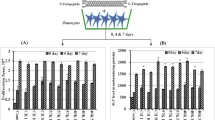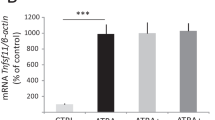Abstract
The effect of zinc compounds on osteoclast-like cell formation in rat marrow culture in vitro was investigated. The bone marrow cells were cultured for 7 days in α-minimal essential medium containing a well-known bone resorbing hormone (1, 25-dihydroxyvitamin D3 and parathyroid hormone [1–34]). Osteoclast-like cell formation was estimated by staining for tartrateresistant acid phosphatase (TRACP), a marker enzyme of osteoclasts. The presence of 1, 25-dihydroxyvitamin D3 (10−8 M) or parathyroid hormone (PTH; 10−8 M) induced a remarkable increase in osteoclast-like multinucleated cells (MNC). These increases were clearly inhibited by the presence of zinc sulfate or zinc-chelating dipeptide (β-alanyl-L-histidinato zinc; AHZ) in the concentration range of 10−7 to 10−5 M. The inhibitory effect was seen at the earlier stage of osteoclast-like MNC formation. However, zinc compounds (10−6 M) did not have an effect on PTH (10−8 M)-induced osteoclast-like cell formation in the presence of EGTA (5 × 10−4 M), dibucaine (10−5 M) or staurosporine (10−9 M). Moreover, when osteoclasts isolated from rat femoraldiaphyseal tissues were cultured for 24 h in the presence of zinc compounds (10−7 to 10−5 M), the compounds did not have an effect on cell numbers or lysosomal enzymes activity (acid phosphatase and β-glucuronidase) in the cells. The present study clearly demonstrates that zinc compounds inhibit osteoclast-like cell formation at the earlier stage with differentiation of marrow cells.
Similar content being viewed by others
References
Prasad AS, Halsted JA, Nadimi M: Syndrome of iron deficiency anemia, hepatosplenomegaly, hypogonadism, dwarfism and geophagia. Am J Med 31: 532–546, 1961
Hurley LS, Gowan J, Milhaud G: Calcium metabolism in manganese-deficient and zinc-deficient rats. Proc Soc Exp Biol Med 130: 856–860, 1969
Oner G, Bhaumick B, Bala RM: Effect of zinc deficiency on serum somatomedin levels and skeletal growth in young rats. Endocrinology 114: 1860–1863, 1984
Yamaguchi M, Yamaguchi R: Action of zinc on bone metabolism in rats. Increases in alkaline phosphatase activity and DNA content. Biochem Pharmacol 35: 773–777, 1986
Yamaguchi M, Oishi H, Suketa Y: Stimulatory effect of zinc on bone formation in tissue culture. Biochem Pharmacol 36: 4007–4012, 1987
Yamaguchi M, Kishi S, Hashizume M: Effect of zinc chelating dipeptides on osteoblastic MC3T3-E1 cells: Activation of aminoacyl-tRNA synthetase. Peptides 15: 1367–1371, 1994
Yamaguchi M, Ozaki K: A new zinc compound, β-alanyl-Lhistidinato zinc, stimulates bone growth in weanling rats. Res Exp Med (Berl) 190: 105–110, 1990
Yamaguchi M, Miwa H: Stimulatory effect of beta-alanyl-Lhistidinato zinc on bone formation in tissue culture. Pharmacology 42:230–240, 1991
Hashizume M, Yamaguchi M: Stimulatory effect of β- alanyl-Lhistidinato zinc on cell proliferation is dependent on protein synthesis in osteoblastic MC3T3-E1 cells. Mol Cell Biochem 122: 59–64, 1993
Yamaguchi M, Kishi S: Prolonged administration of β-alanyl-Lhistidinato zinc prevents bone loss in ovariectomized rats. Japan J Pharmacol 63: 203–207, 1993
Yamaguchi M, Segawa Y, Shimokawa N, Tsuzuike N, Tagashira E: Inhibitory effect of β-alanyl-L-histidinato zinc on bone resorption in tissue culture. Pharmacology 45: 292–300, 1991
Kishi S, Yamaguchi M: Inhibitory effect of zinc compounds on osteoclast-like cell formation in mouse marrow cultures. Biochem Pharmacol 48: 1225–1230, 1994
Takahashi N, Yamana H, Yoshiki S, Roodman GD, Mundy GR, Jones SJ, Boyde A, Suda T: Osteoclast-like cell formation and its regulation by osteotropic hormones in mouse bone marrow cultures. Endocrinology 122: 1373–1382, 1988
Mundy GR, Roodman GD: Osteoclast ontogeny and function. In: W.A. Peck(ed.) Bone and mineral research, Annual 5. Elsevier Science Publishers, Amsterdam, 1987, pp 209–279
Burstone MS: Histochemical demonstration of acid phosphatase with naphthol AS-phosphate. J Nail Cancer Inst 21: 523–539, 1958
Minkin C: Bone acid phosphatase: Tartrate-resistant acid phosphatase as a marker osteoclast function. Calcif Tissue Int 34: 285–290, 1982
Takada Y, Kusuda M, Hiura K, Sato T, Mochizuki H, Nagao Y, Tomura M, Yahiro M, Hakeda Y, Kawashima H, Kumegawa M: A simple method to assess osteoclast-mediated bone resorption using unfractionated bone cells. Bone Miner 17: 347–359, 1992
Tezuka K, Sato T, Kamioka H, Nijweide PJ, Tanaka K, Matsuo T, Ohta M, Kurihara N, Hakeda Y, Kumegawa M: Identification of osteopontin in isolated rabbit osteoclasts. Biochem Biophys Res Commun 186: 911–917, 1992
Walter K, Schutt C: Acid and alkaline phosphatase in serum. In: HU Bergmeyer (ed.) Methods of enzymatic analysis, vols 1 and 2. Academic Press, New York, 1965, pp 856–860
Sokolove PM, Wilcox MA, Thurman RG, Kauffman FC: Stimulation of hepatic microsomal β-glucuronidase by calcium. Biochem Biophys Ress Commun 121: 987–993, 1984
Lowry OH, Rosebrough NJ, Farr AL, Randall RJ: Protein measurement with the Folin phenol reagent. J Biol Chem 193: 265–273, 1951
Sugimoto T, Kanatani M, Kaji H, Yamaguchi T, Fukase M, Chihara K: Second messenger signaling of PTH- and PTHRP-stimulated osteoclast-like cell formation from hemopoietic blast cells. Am J Physiol 265: E367-E373, 1993
Quest AFG, Bloomenthal J, Bardes ESG, Bell RM: The regulatory domain of protein kinase C coordiinates four atoms of zinc. J Biol Chem 207: 10193–10197, 1992
Su Y, Chakraborty M, Nathanson MH, Baron R: Differential effects of the 3′, 5′-cyclic adenosine monophosphate and protein kinase C pathways on the response of isolated rat osteoclasts to calcitonin. Endocrinology 131: 1497–1502, 1992
Vaes G: On the mechanisms of bone resorption. The action of parathyroid hormone on the excretion and synthesis of lysosomal enzymes and on the extracellular release of acid by bone cells. J Cell Biol 39: 676–697, 1968
Author information
Authors and Affiliations
Rights and permissions
About this article
Cite this article
Yamaguchi, M., Kishi, S. Zinc compounds inhibit osteoclast-like cell formation at the earlier stage of rat marrow culture but not osteoclast function. Mol Cell Biochem 158, 171–177 (1996). https://doi.org/10.1007/BF00225843
Received:
Accepted:
Issue Date:
DOI: https://doi.org/10.1007/BF00225843




